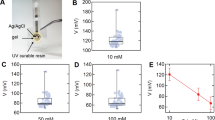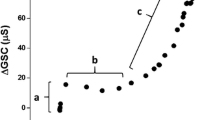Summary
A method is devised where evaporation and dripping sweat rates can be continuously determined during work. 6 unacclimatized men performed work on a bicycle ergometer at 3 different workloads and in 3 humidities. Ambient temperatures were always equal to mean skin temperatures, thus eliminating all sensible heat transfer. Evaporation rates ranged between 6.8 and 11.2 g · min−1. Rates of dripping sweat ranged from a mean of 2.2 to 10.4 g · min−1. One subject dripped 20.3 g · min−1 in condition H3 (70% RH, 100 W). The fully wet skin in condition H3 corresponded to an evaporative heat transfer coefficient of 99 W · m−2 kPa. Efficiency of sweating, defined as the ratio between secreted and evaporated sweat, ranged from 87 (50% RH, 50 W) to 51% (70% RH, 100 W). Corresponding values of wettedness were 0.56 and 1.0. Efficiency fell to 51% for fully wet skin (H3), and in some subjects the efficiency values were remarkably low. One subject displayed an efficiency of 31% in condition H3. The reduction in efficiency at a given level of wettedness was higher than previously reported.
Similar content being viewed by others
References
åstrand I (1960) Aerobic work capacity in men and women with special reference to age. Acta Physiol Scand 49: Suppl 169
åstrand PO, Rodahl K (1980) Textbook of work Physiology. Mc Graw-Hill, Book Comp., New York pp 339–341
Belding HS, Kamon E (1973) Evaporative coefficients for prediction of safe limits in prolonged exposures to work under hot conditions. Fed Proc 32:1598–1601
Berglund LG, Gonzalez RR (1977) Evaporation of sweat from sedentary man in humid environments. J Appl Physiol: Respirat Environ Exercise Physiol 42(5):767–772
Candas V, Libert JP, Vogt JJ (1979) Human skin wettedness and evaporative efficiency of sweating. J Appl Physiol Respirat Environ Exercise Physiol 46:522–528
Candas V, Libert JP, Vogt JJ (1979) Influence of air velocity and heat acclimation on human skin wettedness and sweating efficiency. J Appl Physiol: Respirat Environ Exercise Physiol 47(6):1194–1200
Drinkwater BL, Bedi JF, Loucks AB, Roche S, Horvath SM (1982) Sweating sensitivity and capacity of woman in relation to age. J Appl Physiol: Respirat Environ Exercise Physiol 53:671–676
Fanger PO (1970) Thermal Comfort. Danish Technical Press Copenhagen
Frye AJ, Kamon E (1983) Sweating efficiency in acclimated men and women exercising in humid and dry heat. J Appl Physiol: Respirat Environ Exercise Physiol 54:972–977
Givoni B (1976) Man, climate and architecture. Applied Science Publishers, London, pp 27–29
Holmér I, ElnÄs S (1981) Physiological evaluation of the resistance to evaporative heat transfer by clothing. Ergonomics 24:63–74
Kerslake D McK (1972) The stress of hot environments. Cambridge University Press, Cambridge
Libert JP, Candas V, Vogt JJ (1978) Sweating response in man during transient raises of air temperature. J Appl Physiol Environ Exercise Physiol 44:284–290
Mc Lean JA (1974) Loss of heat by evaporation. Heat loss from animals and man. Buttersworth, London, pp 19–31
Nishi Y, Gagge AP (1970) Direct evaluation of convective heat transfer coefficient by naphtalene sublimation. J Appl Physiol 29:830–838
Roberts MFC, Wenger B, Stolwijk JAJ, Nadel ER (1977) Skin blood flow and sweating changes following exercise training and heat acclimation. J Appl Physiol: Respirat Environ Exercise Physiol 43:133–137
Author information
Authors and Affiliations
Rights and permissions
About this article
Cite this article
Alber-Wallerström, B., Holmér, I. Efficiency of sweat evaporation in unacclimatized man working in a hot humid environment. Europ. J. Appl. Physiol. 54, 480–487 (1985). https://doi.org/10.1007/BF00422956
Accepted:
Issue Date:
DOI: https://doi.org/10.1007/BF00422956




